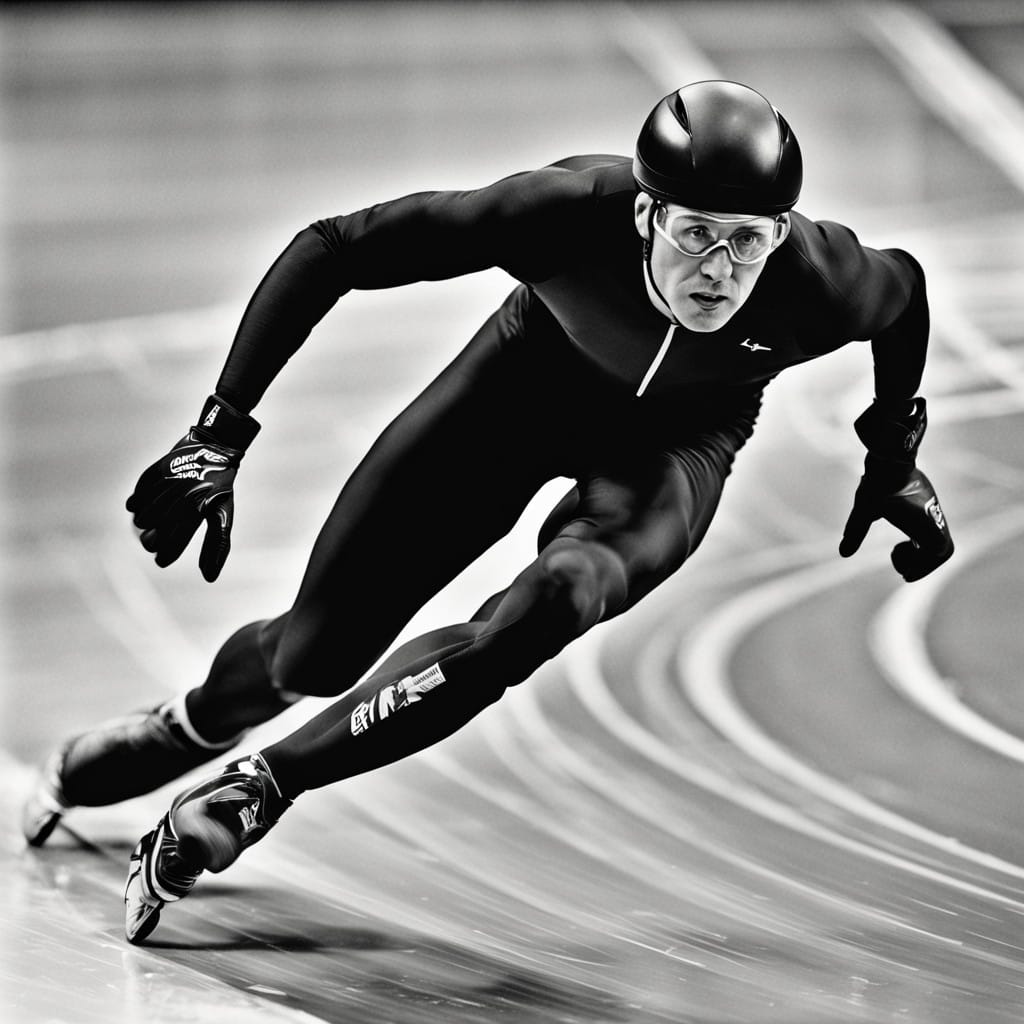The Thrilling World of Speed Skating

Speed Skating is a sport that combines athleticism, precision, and speed, captivating audiences worldwide. This dynamic sport, with its unique blend of grace and velocity, has a rich history and a significant presence on the global stage. In this comprehensive blog post, we will delve into the origins of Speed Skating, its global popularity, the amateur scene, professional leagues, political and social significance, and the rules that govern this exhilarating sport.
Origins and History
Speed Skating traces its roots back to Northern Europe, specifically Scandinavia and the Netherlands. The sport’s inception dates back to the early 13th century when people skated on frozen rivers and canals. These early skates were made from animal bones, strapped to the feet with leather thongs. The Dutch are often credited with formalizing Speed Skating. By the 17th century, skating clubs were established, and races began to be organized.
The first recorded Speed Skating race took place in England in 1763. This event marked the beginning of organized competitions. By the 19th century, Speed Skating had spread to North America. The first official World Championships were held in the Netherlands in 1889. This event signified the sport’s growing international appeal.
Speed Skating was included in the first Winter Olympics in 1924. This inclusion boosted its global profile. The sport continued to evolve, with innovations in equipment and training techniques. The introduction of artificial ice rinks in the mid-20th century allowed for more consistent conditions. This development was crucial for the sport’s growth.
In the latter half of the 20th century, Speed Skating saw the rise of legendary athletes. Names like Eric Heiden, who won five gold medals at the 1980 Winter Olympics, and Bonnie Blair, who won six Olympic medals, became synonymous with the sport. These athletes’ achievements helped to further popularize Speed Skating.
Global Popularity
Speed Skating has a strong following in several countries. The Netherlands is arguably the sport’s heartland. Dutch skaters have dominated international competitions, and the sport enjoys immense popularity among the Dutch public. Speed Skating is a national pastime in the Netherlands, with major events drawing large crowds.
In North America, Speed Skating has a significant presence in both the United States and Canada. The sport has produced numerous Olympic champions and has a dedicated fan base. In the United States, regions with cold winters, such as the Midwest, are particularly passionate about Speed Skating.
In Asia, Speed Skating has gained considerable traction. Countries like South Korea, Japan, and China have invested heavily in the sport. South Korea, in particular, has become a powerhouse in short track Speed Skating. The success of athletes like Lee Seung-hoon and Shim Suk-hee has inspired a new generation of skaters.
Speed Skating is also popular in Russia and other parts of Eastern Europe. Russian skaters have a long history of success in international competitions. The sport is supported by a strong infrastructure of training facilities and coaching programs.
In other parts of the world, Speed Skating is growing in popularity. Countries in Scandinavia, such as Norway and Sweden, have a strong Speed Skating tradition. Australia and New Zealand have also seen an increase in interest, particularly in short track Speed Skating.
Youth and Schools
Amateur Speed Skating is the foundation of the sport. It begins at the grassroots level, with youth programs and school competitions playing a crucial role. In countries where Speed Skating is popular, children often start skating at a young age. They begin with basic skating skills before progressing to Speed Skating techniques.
In the Netherlands, for example, many children learn to skate on frozen canals during the winter. Local clubs offer training programs for young skaters. These programs focus on developing fundamental skills and fostering a love for the sport. School competitions are also common, providing young skaters with opportunities to compete and improve.
In the United States and Canada, youth Speed Skating programs are widespread. Many cities have Speed Skating clubs that offer training for children and teenagers. These clubs often have partnerships with local schools, making it easier for students to participate. High school competitions are an important part of the amateur Speed Skating scene in North America.
Asia has seen significant growth in youth Speed Skating. In South Korea, the government supports programs aimed at identifying and nurturing young talent. Schools often have Speed Skating teams, and competitions are held at various levels. Similar efforts are underway in Japan and China, where youth development is a key focus.
Youth Speed Skating programs emphasize skill development, sportsmanship, and physical fitness. Coaches play a vital role in guiding young skaters, helping them to refine their technique and achieve their potential. As these skaters progress, they may move on to higher levels of competition, such as national championships and international events.
Professional Leagues and Competitions
Professional Speed Skating is a highly competitive arena. Athletes train rigorously to compete at the highest levels, aiming for success in prestigious events. The International Skating Union (ISU) is the governing body. It oversees major competitions, including the World Championships and the World Cup series.
The World Cup series is a key component of professional Speed Skating. Held annually, it consists of multiple events in different countries. Skaters accumulate points based on their performance, with overall champions crowned at the end of the season. The World Cup series attracts the best skaters from around the globe.
The World Championships are another highlight of the professional calendar. These events include both individual distances and all-around competitions. The all-around competition tests skaters’ versatility across multiple distances. Winning a World Championship title is a significant achievement in a skater’s career.
The Olympic Games are the pinnacle of Speed Skating. Held every four years, the Winter Olympics feature both long track and short track events. Olympic champions often become national heroes, and their performances inspire future generations. The Olympics provide a global stage for the sport, showcasing its excitement and drama.
In addition to these major competitions, there are professional leagues in some countries. In the Netherlands, the KNSB Marathon Cup is a popular long-distance series. Skaters compete in races held on natural ice whenever possible. These marathon events draw large crowds and are a unique aspect of Dutch culture.
Political and Social Significance
Speed Skating holds significant political and social importance in many countries. In the Netherlands, the sport is a symbol of national identity. The Elfstedentocht, an iconic long-distance race held on natural ice, is a prime example. This event captures the Dutch spirit of resilience and community, drawing participants and spectators from all over the country.
In countries like South Korea, it’s success has bolstered national pride. The achievements of skaters on the international stage are celebrated as symbols of the nation’s strength and determination. Government support for the sport reflects its importance in promoting national unity and international recognition.
It has also played a role in breaking down social barriers. In the United States, for example, African American skater Shani Davis made history by winning Olympic gold. His success challenged stereotypes and inspired greater diversity in the sport. Similarly, female skaters like Bonnie Blair have paved the way for women promoting gender equality.
The sport’s social impact extends to community engagement. Clubs and events often bring people together, fostering a sense of camaraderie and shared passion. Local competitions and festivals provide opportunities for social interaction and community building. In this way, it contributes to social cohesion and well-being.
The Rules
Understanding the rules is essential for appreciating the sport. There are two main types: long track and short track. Each has its own set of rules and characteristics.
In long track, skaters compete on a 400-meter oval track. Races are held over various distances, ranging from 500 meters to 10,000 meters. Skaters race in pairs, starting in separate lanes. They switch lanes on each lap to ensure equal distance covered. The skater with the fastest time wins.
Short track, on the other hand, takes place on a smaller, 111.12-meter oval track. Multiple skaters compete in each race, which can lead to exciting and chaotic action. Distances range from 500 meters to 3,000 meters. The first skater to cross the finish line wins, but there are strict rules to prevent interference and ensure fair competition.
In both disciplines, skaters must adhere to strict regulations regarding equipment. Skates must meet specific standards, and protective gear is mandatory. In short track, skaters wear helmets, gloves, knee pads, and neck guards to protect against falls and collisions.
Penalties are an important aspect of the rules. In short track, skaters can be disqualified for infractions such as impeding, where a skater obstructs an opponent. In long track, false starts and lane violations can result in penalties. Judges closely monitor races to ensure fair play.
Understanding the rules enhances the spectator experience. Knowing the intricacies of lane changes, penalties, and timing allows fans to appreciate the strategy and skill involved. The rules also ensure that the competition is fair and that the best skater emerges victorious.
Conclusion
Speed Skating is a sport that captivates with its blend of speed, skill, and strategy. Its rich history, from frozen canals in the Netherlands to the global stage of the Olympics, reflects its enduring appeal. The sport’s popularity spans continents, with passionate communities in Europe, North America, and Asia.
At the amateur level, Speed Skating nurtures young talent and fosters a love for the sport. Professional leagues and competitions showcase the pinnacle of athletic achievement. The political and social significance underscores its impact beyond the ice.
Finally, the rules ensure that the sport remains fair and exciting. Whether you’re a seasoned fan or a newcomer, the world of Speed Skating offers something for everyone. The sport’s thrilling races and storied traditions continue to inspire and unite people around the world.




